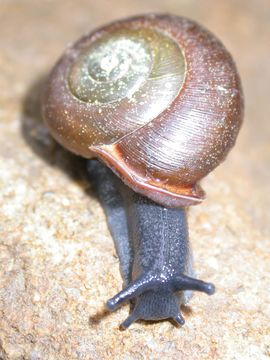Classification
Domain- Eukarya
(Encyclopedia of Life, 2012)
Members within this Domain, including Inflectarius
ferrissi, have membrane bound organelles and a true nucleus, which contains
DNA
(Hickman et al., 2009).
Kingdom- Animalia
(Encyclopedia of Life, 2012)
Organisms within the Kingdom Animalia are multicellular
heterotrophs
(Hickman et al., 2009). They are typically
mobile and lack cell walls
(Hickman et al., 2009).
Phylum- Mollusca
(Encyclopedia of Life, 2012)
Characteristics of molluscs include having a head,
visceral mass (hump), and a ventral muscular foot
(Gillis, 2012).
Although there are many modifications among species within the
phylum, most molluscs, including Inflectarius ferrissi, have a mantle
specialized for gas exchange, a radula, and a shell that is secreted by
epidermal tissue
(Gillis, 2012).
Class- Gastropoda
(Encyclopedia of Life, 2012)
Members of the Class Gastropoda, or the “belly foots,”
typically have a single shell that is usually coiled
(Gillis, 2012).
Gastropods, including I. ferrissi, are distinguishable from other
molluscs because they go through torsion, or a 180° twisting of the visceral
mass; this brings the anus in a position above the head
(Gillis, 2012).
Order- Stylommatophora
(Encyclopedia of Life, 2012)
All gastropods, including I. ferrissi, within the Order
Stylommatophora are terrestrial and air-breathing; they have tentacles in
which eyes are found on the tips
(Dictionary.com, 2012).
Family-Polygyridae (Encyclopedia of Life, 2012)
Family Polygyridae consists of terrestrial air-breathing snails
(Dictionary.com, 2012).
Genus-Inflectarius
(Encyclopedia of Life, 2012)
The latin root flect means bend
(Solem, 1955).
It is believed that Inflectarius ferrissi is included within this
Genus due to the development of a reflected lip
(Solem, 1955).
Species-Inflectarius ferrissi
(Encyclopedia of Life,
2012)
I. ferrissi, commonly known as the Smoky
Mountain Covert, was discovered by and named after James H. Ferriss who had collected specimens on a trip through the Smoky Mountains
during the summer of 1897
(Solem, 1955). Along with
a
reflected lip, I. ferrissi ceases growing at maturity, which makes it difficult to
accurately estimate age
(Solem, 1955).